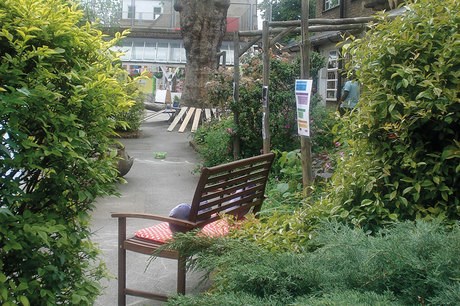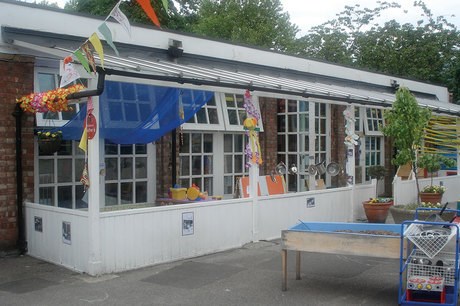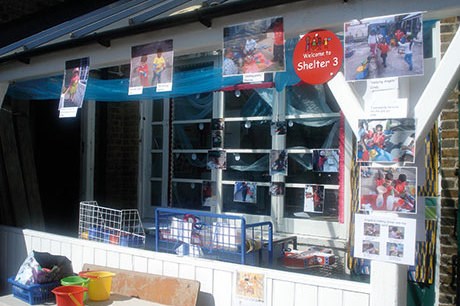Enabling Environments: Outdoors - Taking shelter
Nicole Weinstein
Monday, March 20, 2017
The children are free to roam from shelter to shelter while enjoying the outdoors at England’s first ‘open air’ nursery, situated in south east London. Nicole Weinstein reports

Nestled between the high-rise buildings in London’s Royal Borough of Greenwich is a small oasis with a pond, a hill, large pine trees and an amphitheatre, all surrounding a series of classrooms known as ‘shelters’.
Children from the ages of two to four attending Rachel McMillan Nursery School and Children’s Centre in Deptford, south east London, start off the day in their own shelters before being free to roam the site, visiting friends in other shelters, playing in the sandpit or on the climbing frames – and even accessing a roof garden that sits on top of one of the shelters.
‘Each shelter is in a separate building – it’s like a little village,’ explains Theresa Lane, who has been the head teacher at England’s first ‘open air’ nursery for 11 years.
She adds, ‘With such an extensive outdoor area that is fully accessible to each child throughout the day, making the decision to integrate the two-year-olds with the three- and four-year-olds was not a decision we took lightly. But since we made that change in September 2015, we haven’t looked back.
‘The two-year-olds are thriving – physically and emotionally – and it’s a much more natural environment for them to be in.’
THE SHELTERS
The nursery was originally set up in 1914 by two sisters – Rachel and Margaret McMillan – to help children living in slum conditions. Today it still retains much of its original design and layout; however, the original shelters, which were three-sided buildings with canvas on the fourth side intended for sheltering from the worst weather, have now been replaced with London brick and are Grade 2-listed buildings.
There are six shelters dotted around the site, used specifically as classrooms, children’s centre activities, and one for staff professional development and courses for parents or other professionals. One is used for sensory circuits for children with social communication challenges or autism (see box), and is also used by the two-year-olds for stories and age-appropriate activities.
Each shelter has a qualified teacher; a nursery nurse; a teaching assistant; a lunchtime teaching assistant; a two-year-olds’ practitioner; and often an extra teaching assistant to make the team larger if there are children with a special educational need or disability who need extra support.
‘We very much follow the philosophy of the McMillan sisters,’ explains Ms Lane. ‘The children are outside most of the time and in all weathers. We all have wet-weather gear and we aim for healthy, resilient, resourceful, adventurous, independent learners – both staff and children!’
THE CHALLENGES
Most of the children live in small flats in and around Deptford, often without any outdoor space, which is why the nursery’s ‘wonderful, large garden is a great place to be a child’, explains Ms Lane.
She adds, ‘It gives them an immense amount of freedom to follow their passions and interests, which the very skilled staff scaffold, follow, support and extend.’
However, she admits that staffing the large outdoor area doesn’t come ‘without its challenges’. She says, ‘We could not possibly run it safely and get the quality we do on 1:13, which is the ratio for three- and four-year-olds if there are teachers. We run on a 1:9 ratio – and 1:4 for two-year-olds – and even this stretches us to the limit.’
The large intake of children with special needs allows the setting to receive funding from the Royal Borough of Greenwich to employ extra teaching assistants. ‘These members of staff don’t work on a one-to-one basis because we do not believe this is in the best interest of the child, so they work on the staff rota with joint responsibility for all the children,’ says Ms Lane.
THE BENEFITS
The two-year-olds were historically housed in their own shelter during the first year that the nursery was involved in the pilot scheme for the two-year-olds’ entitlement. They moved into the same shelter that was used for the babies before it closed down in 2013 after the council could no longer afford to subsidise it.
But the staff noticed that the two-year-olds used to play outside with the older children in the big garden and have a great time. It took a year to work out the logistics of integrating the two-year-olds, and there were initial concerns about safety, but Ms Lane says their anxieties have been unfounded. ‘The two-year-olds have blossomed,’ she comments. ‘It’s much more natural for them to be with the older children; the older children like them because they are younger – we have to, on occasion, stop them from “babying” them. The older children are their role models – they flourish physically because they have a lot more space and they have the opportunity to interact with a wider age group instead of just being with two-year-olds. They have definitely become more independent.’
Another benefit is that it has cut out a transition because children will stay in the same shelter from the age of two until they go to school.
There are 32 two-year-olds at the setting and 104 full-time-equivalent places. Each morning and afternoon, there are four two-year-olds in each shelter, each with a dedicated member of staff on a 1:4 ratio. The two-year-olds arrive at 8.45am, 15 minutes before the older children, to give them some quiet time to settle in. At the end of the three-hour session, the practitioners take all the two-year-olds for a story, song and snack together.
‘This is the only real difference in their day, along with the fact that their dedicated practitioner can roam a bit more freely around site with them,’ says Ms Lane. ‘Some children just go off and play and are fine, but some need to stay close to an adult to start with because they are still quite tiny.’
THE SENSORY CIRCUIT SHELTER

‘We are seeing more and more children coming through with social communication skills and autism,’ explains Ms Lane. ‘In all my career I’ve never known so many children with it, which is why we are using our empty shelter for one-to-one individually tailored sensory circuit sessions.
‘We employ, together with three other nursery schools in Greenwich, a social communication worker who is on the Autistic Spectrum Disorder team within the Royal Borough of Greenwich. She visits each nursery one day a week and works with the children and alongside practitioners, advising them if a circuit is needed for a specific child and, if so, what to put in it.
‘The sensory circuit shelter is pretty much timetabled for back-to-back 10- to 15-minute sessions on a daily basis. The room itself is very bland and purposefully not decorated in the same way as the other shelters because we want the environment to be as non-distracting as possible. There are a few cupboards and tables, a little trampoline, a swing for vestibular activities and carpet space for two-year-olds to go in for story time.
‘A typical sensory circuit has something that alerts you; something that calms you down and something where you have to follow an instruction.
‘It could be bouncing on a trampoline while you sing a song; balancing on stepping stones or rolling on large gym balls – or having the ball rolled on the child as a massage-type activity.’
There are currently four children diagnosed with autism at the setting and 10 who possibly have the condition. ‘There is a 14-month wait to be seen at a clinic in the Royal Borough of Greenwich at the moment,’ comments Ms Lane. ‘We are collecting evidence and bringing in educational psychologists and doing whatever we can pre-diagnosis, as evidence is needed for an Education, Health and Care Plan.
‘The reality is that nearly all children get a diagnosis when they start primary school or just before.’




